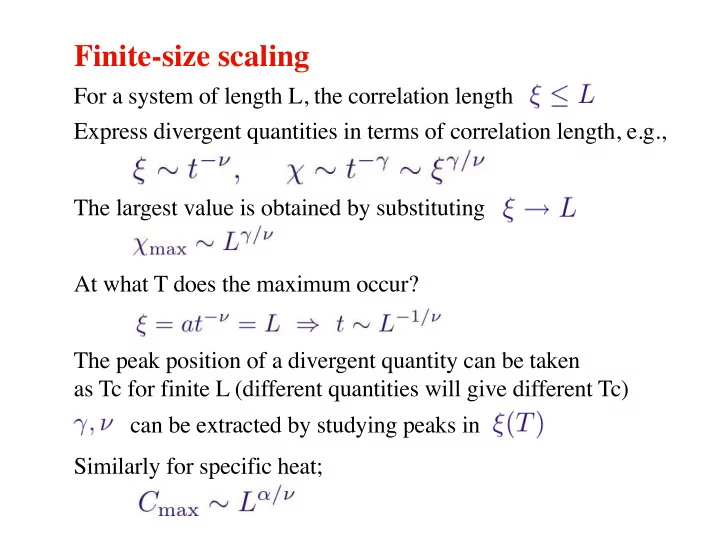

Finite-size scaling For a system of length L, the correlation length Express divergent quantities in terms of correlation length, e.g., The largest value is obtained by substituting At what T does the maximum occur? The peak position of a divergent quantity can be taken as Tc for finite L (different quantities will give different Tc) can be extracted by studying peaks in Similarly for specific heat;
Susceptibility: Diverges at the transition:
On a logarithmic scale
Specific heat (actually 𝛽 =0 and log divergence for 2D Ising)
General finite-size scaling hypothesis The ratio should control the behavior of finite-size data also close to Tc Test this finite-size scaling form What is the exponent σ ? We know that for fixed (small) t, the infinite L form should be To reproduce this, the scaling function must have the limit We can determine the exponents as follows Hence Find g by graphing versus
2D Ising model; In general; find Tc and exponents so that large-L curves scale
Binder ratio Useful dimensionless quantity for accurately locating Tc Infinite-size behavior: Implies finite-size scalings Hence Q should be size-independent at the critical point Q(L) curves for different L cross at Tc; often small corrections
Binder ratio: Q is size independent at Tc (useful for locating Tc)
Crossing points for, e.g., sizes L, 2L can be extrapolated to infinite L to give an accurate value for Tc - in many cases: sufficient accuracy for two large sizes
Autocorrelation functions Value of some quantity at Monte Carlo step i: The autocorrelation function measures how a quantity becomes statistically independent from its value at previous steps (time averages) Asymptotical decay Integerated autocorrelation time Critical slowing down At a critical point for system of length L; Q=order parameter
How to calculate autocorrelation functions If we want autocorrelations for up to K MC step separations, we need to store K successive measurements of quantity Q Store values in vector tobs(K) ; first k steps to fill the vector. Then, shift values after each step, add latest measurement: Accumulate time-averaged correlation functions do t=2,k tobs(t)=tobs(t-1) enddo tobs(1)=q do t=0,k-1 acorr(t)=acorr(t)+tobs(1)*tobs(1+t) enddo
2D Ising autocorrelation functions for |M| T/J=3.0 > Tc Exponentially decaying autocorrelation function - convergent autocorrelation time
T/J = 2.269 = Tc Autocorrelation time diverges with L
Critical slowing down Dynamic exponent Z: For the Metropolis algorithm (Metropolis dynamics)
Recommend
More recommend